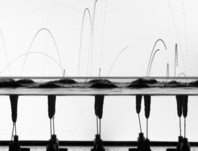Research
Ocean Spray

Understanding the clouds formation by studying a great multitude of bursting bubbles? This is the approach we follow in Deike Lab at Princeton University, under the impulsion of Luc Deike. Sea spray aerosols, those solid, mostly salt particles, that are transported by winds in the atmosphere and act as nuclei for vapor water to condense under appropriate conditions, can count on a significant contribution from the droplets ejected when bubbles pop at the surface of the ocean. I investigate, by way of controlled meter-scale experiments, collective effects in the bursting of an ensemble of surface bubbles and the subsequent spray production.
Liquid Fragmentation

How to break apart a given volume of liquid, and create interfaces? This statement, apparently contradictory with the surface minimization principle founding surface tension, is a core question of interfacial fluid dynamics, applying to sprays, engine combustion, interface stability, capillary destabilization, etc. I made experimental contributions to the field by working on the rupture and destabilization of liquid sheets, an intermediate stage in the formation of sprays, and bringing some insights into the impact and splashing of liquid rims.
Granular Matter

Sand, contrary to water, can sustain a certain tilt, a key feature to form heaps and sand edifices. The threshold is somewhat decreased when the grains are vibrated, another essential feature we most likely have all experienced one day. Avalanches, silo storage, dunes, are some of my motivations to study, at a fundamental level, the different states of a shaken ensemble of grains.



